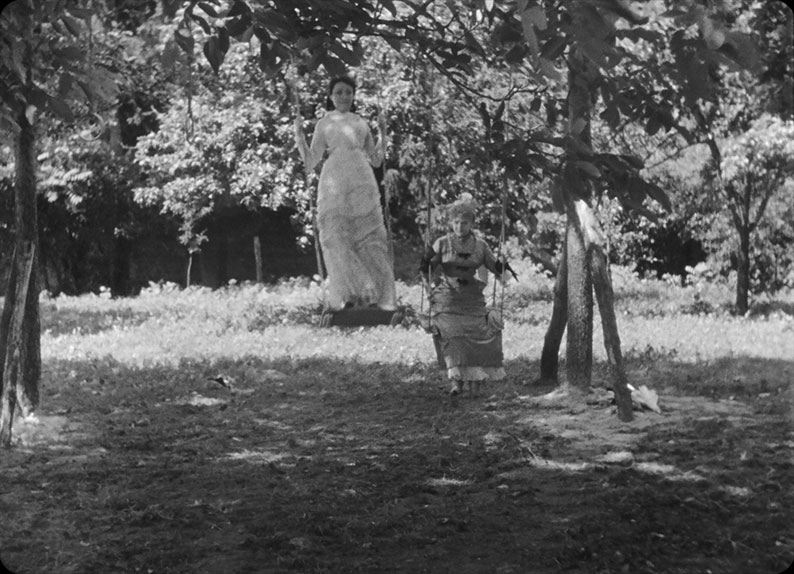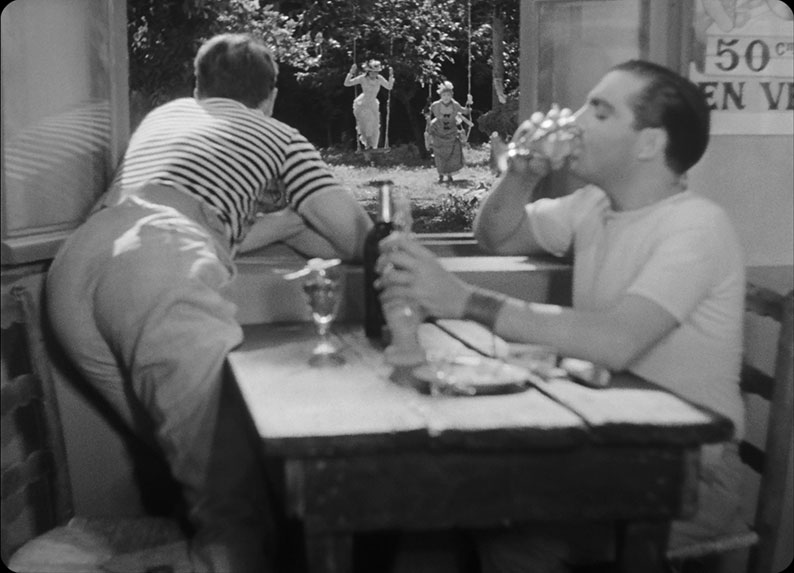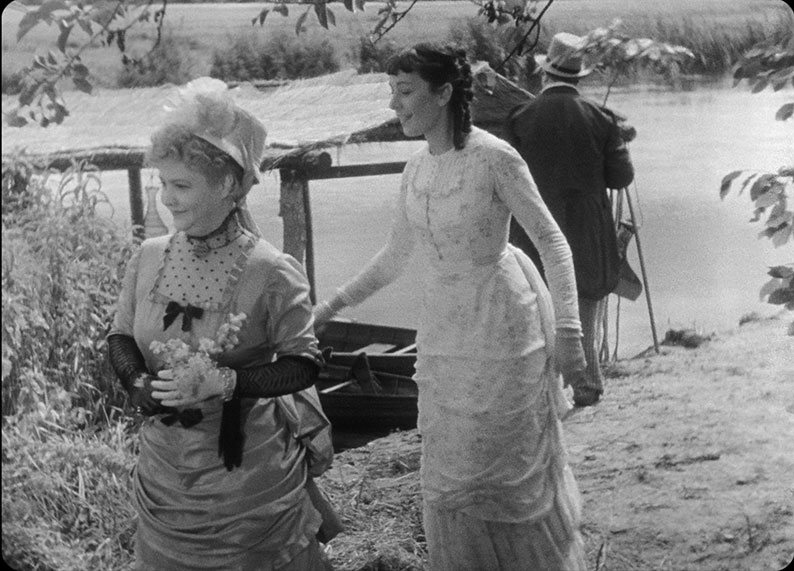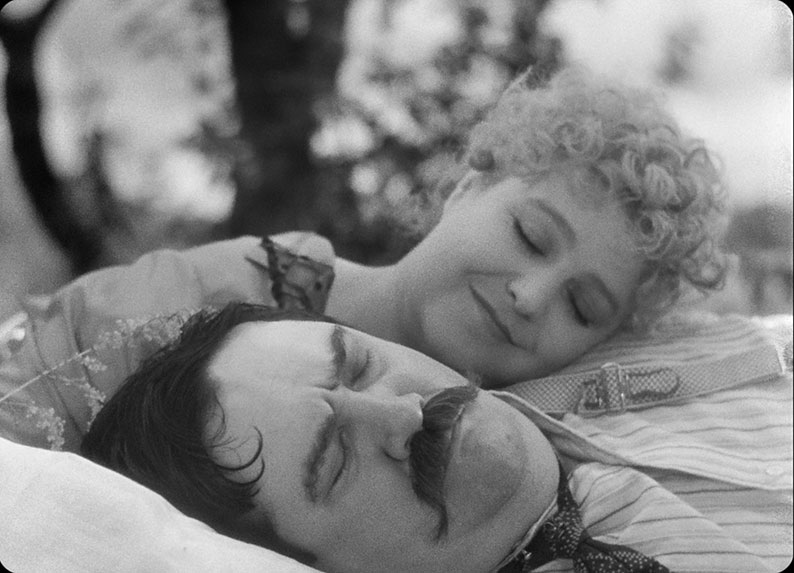|
France, 1860. On a summer Sunday, Monsieur Dufour (André Gabriello), owner of a Parisian hardware shop, borrows a milk cart and uses it to spend a day in the countryside. Accompanying him are his wife (Jane Marken), mother-in-law (Gabrielle Fontan) and daughter Henriette (Sylvia Bataille) and shop assistant Anatole (Paul Temps). At a roadside hostelry, two men, Henri (Georges Saint-Saens) and Rodolphe (Jacques Borel), take note of Henriette and her mother and are determined to pursue them...
Partie de campagne (A Day in the Country) is one of the great unfinished films. Jean Renoir, who clearly had a conflicted relationship with this one of his films, would insist that the film we now have was actually finished and that the version we have was the one he intended. However, adverse weather curtailed the location shoot and two scenes in the script (which survives) were not filmed. The film was always intended to be mid-length, either a long short or a very short feature according to your definition. It’s a court-métrage as the French say, based on what is a short story, 4000 words long in the original French, with a hat-tip to Project Gutenberg. And so it was, at just under forty minutes, that it saw the light of a projector carbon-arc.

The film is based on a short story by Guy de Maupassant, “Une partie de campagne”. (The film title drops the indefinite article.) The film is faithful to the story, though the weather during production was not the blazing sunshine as described in the original story. Partie de campagne is a film with a lot of personal resonance for Renoir. He had not met de Maupassant, who had died a year before he was born, but the writer had been a close friend of Renoir’s father, the artist Auguste. In many ways, Renoir’s film puts the filmmaker in dialogue with his father, with many scenes evoking the style of the paintings, with 35mm black and white film in counterpoint to the colours of paint. The family connections go further: Renoir’s partner Marguerite Renoir plays a waitress and, billed as Marguerite Houle Renoir (they never married though she did take his surname) was the film’s editor, his nephew Claude was the cinematographer and Renoir’s son Alain can be seen fishing off a river bridge near the start. Renoir himself takes an acting role, as Père Poulain, the proprietor of the restaurant the travellers visit. Future director Jacques Becker was Renoir’s assistant and Luchino Visconti, uncredited, the set dresser. Becker, photographer Henri Cartier-Bresson (the film’s second assistant director, credited thus as “Henri Cartier”) and author Georges Bataille (husband of Sylvia) appear on screen as a group of seminarians passing by at one point.
At the time, Renoir was associated with the political Left, something overt in his two previous films, Le crime de Monsieur Lange and La vie est à nous (both 1936, the latter available as an extra on the BFI’s release of La règle du jeu) and the one he would make two years later, La Marseillaise, and certainly present in most of his 1930s films. Partie de campagne is often seen as a lighter-toned exception to this amongst Renoir’s films of the time, but that’s deceptive: an awareness of the class system, and its effect on people and their happiness, is very evident. The film is more an observation of character and evocation of mood than one driven by its plot, but in the midst of the summer frolics there’s an undertone of melancholy. Days like this will pass and won’t last. An epilogue casts a sad, years later, reflection on the events of the main part of the film.
Renoir’s direction is lightness itself, and this film shows that he was exploring the possibilities of deep focus and staging in depth, often using longer takes than usual. This was before directors like Orson Welles and William Wyler, and cinematographers like Gregg Toland, were similarly experimenting in Hollywood. Early on, a scene begins in medium close shot with Henri and Rodolphe talking. Then Rodolphe opens the window shutters to reveal characters in the far distance, all in focus, an impeccable piece of directorial showmanship. (If you look closely, though, there’s a very quick focus pull from foreground to background.) Renoir would continue to explore the possibilities of this kind of staging in later films, with La règle du jeu containing several notable examples.

If Renoir was channelling his father and his father’s friend, there’s no doubt his film has had its own influence. Another then French-based filmmaker, Max Ophuls, dramatised three de Maupassant stories in his 1952 portmanteau feature Le plaisir, and “La maison Tellier”, the hour-long middle section, is the closest in style and theme to Partie de campagne. Much later, I’m sure that Bertrand Tavernier had Renoir’s film in mind when he made Sunday in the Country (Un dimanche à la campagne), though Tavernier’s film is not based on de Maupassant.
Partie de campagne was scheduled to be shot over eight days on location and two in the studio. However, the wettest French summer in years held things up considerably. The shoot was not a happy one, with the atmosphere becoming increasing toxic as nobody could work and money was beginning to run out. Renoir became increasingly disaffected and some of the film was shot by Jacques Becker, before Renoir finally left to make his next film Les bas-fonds, something Sylvia Bataille particularly resented, as she had not been allowed to travel to Paris to audition for a future film there. The two days in the studio, being the two missing scenes in the script, never happened. The production began on 27 June and ended on 15 August.
The film formally abandoned, producer Pierre Braunberger had to wait until the end of World War II to receive the footage from the labs. The original edits had been destroyed, but the film’s negative had been preserved by Henri Langlois at the Cinémathèque Française. Marguerite Renoir reedited the film and Joseph Kosma added a music score. Renoir was not involved as he was then living and working in America, and by all accounts was not encouraging. Two captions were added to aid viewer comprehension and to plug the gaps left by the missing scenes. (The present version has an additional caption at the start, detailing the circumstances of the film’s production.) The Visa de censure date, which appears at the start of the current Blu-ray transfer, is 8 May 1946). Partie de campagne was released in the UK in October 1947. The Monthly Film Bulletin’s anonymous reviewer saw the film in musical terms, not just the score which he/she describes thus: “It starts, and largely proceeds, in and around C major, and among its merits are the clarity and directness of its motivic and tonal relationships.” That’s more musicology than you might expect in a film review. In 1950, the film was released in the USA as part of a triple feature called The Ways of Love with two other mid-length films, Roberto Rossellini’s The Miracle and Marcel Pagnol’s Jofroi.

If Partie de campagne had been completed and released at the time it was made, we would see it clearly as part of a banner year for Renoir (similar to 1957 for Ingmar Bergman, though he was even more prolific). The year had seen the release of Le crime de Monsieur Lange, the making and release of La vie est à nous, the screenplay of La grande illusion (released the following year) and pre-production of La Marseillaise. However, incomplete and not loved, it wasn’t seen until ten years later, generally disowned by its own director. However, over the years its reputation has risen, and if not seen to achieve the heights of, say, La grande illusion or La règle du jeu, still a vital part of the peak decade in the career of one of the great filmmakers of the twentieth century.
Partie de campagne is a Blu-ray release from the BFI, encoded for Region B only. The film was given an A certificate by the BBFC in 1947 and is now a PG.
As the film was shot in black and white 35mm, the Blu-ray transfer is in the intended Academy Ratio, 1.37:1, complete with rounded corners to the frames. The transfer is based on a 2013 digital restoration and is very clear and sharp, with solid blacks and greyscale on point. Grain is natural and filmlike. It wasn’t filmed yesterday, but it looks like it could have been.
The soundtrack is the original mono, rendered as LPCM 2.0. Some of the limitations of 1936 sound technology are evident, with a reduced dynamic range, mostly middle with little bass and occasionally harsh top ends, but dialogue, music and sound effects are well balanced. English subtitles are enabled by default for the main film and the out-takes. There isn’t an option to remove them on the disc menu, if you’re sufficiently Francophone, but I was able to do so using my player remote.
Commentary by Philip Kemp
Recorded in 2003 for the BFI’s previous DVD release, Kemp’s commentary begins after a minute and winds up a little before the end, but given the film’s short length is well paced and covers all the bases. He starts by talking about Renoir’s account of his father and de Maupassant’s friendship, given that the two men seem to have had nothing in common. (Renoir Senior was too much the optimist for de Maupassant, while the writer was too much the pessimist for the painter.) He talks about the film’s troubled production, abandonment and eventual release, and attempts to remake the film as a feature, though this was something Renoir showed no interest in.
Jean Renoir lecture (89:07)
This is a recording of a lecture from 1963, during a retrospective of Renoir’s films at the then National Film Theatre. Many of these audio recordings (and sometimes, later, video recordings) at the NFT took the form of interviews, usually by a film critic, even if they were billed as John Player or Guardian Lectures due to sponsorship. This is however different: there’s no introduction (on this recording anyway), though there is a brief piece from a compere at the end, and Renoir speaks directly to the audience. He talks in English, inevitably with an accent, and the recording quality is a little rough, but most people are likely to be able to follow him. He begins by saying that the most important goal of a filmmaker is “the destruction of cliché” and suggests that we are all creatures of chance and fate, of what we are given at birth, and masterpieces are made by accident rather than design, and imperfections make us see the artist in the artwork. Renoir speaks for twenty-five minutes and then takes questions from the audience – which, as usual for these audio recordings not made with commercial release in mind, are not always easy to make out. The lecture is mostly theoretical, but the questions ask more nuts-and-bolts things, such as how he worked with actors.
This item is available as an alternative audio track to Tournage à la campagne (see below).

Tournage à la campagne (89:16)
An assembly of outtakes from the film, which had been deposited at the Cinemathèque Française in 1962 by Pierre Braunberger. They are put together in story order, with no music score but with occasionally rough direct sound, and now and again the voice of Renoir from behind the camera. Clapperboards make several appearances, and reveal that the working title of the film was Une partie de campagne, with de Maupassant’s indefinite article intact. Scenes are identified by letter rather than number. This compilation was shown at the Cinémathèque during their celebration of Renoir’s centenary in 1994.
Screen tests (9:03)
As it says, nine minutes of tests of the actors, including Renoir himself, with some clapperboards. These are presented mute, though if you can lipread in French (I can’t), you might be able to make out what these men and women are saying.
Booklet
The BFI’s booklet, available with the first pressing only, begins with “From Magnificent Torso to Perfectly Finished Work” by Barry Nevin which neatly tracks the rise in the film’s reputation over the years. It begins by describing how considerable a year 1936 was in Renoir’s career and how significant the year was in France as a whole, with a leftist government bringing in such thing as paid holidays and a forty-hour working week. Nevin covers the film’s troubled production and lengthy post-production and ends by quoting Renoir in his autobiography. Renoir saw the lighthearted (on the surface) mood of the film as emblematic of French society at the time, optimistic and, in his words, the French truly believing “that they were going to love one another”. It was not to last, of course.
Next up, Pasquale Iannone looks at the various cinema adaptations of Guy de Maupassant, a writer who just missed the beginning of the cinema. He begins by discussing the differences in adapting novels and short stories, the latter requiring additions rather than abridgements. Iannone then goes on to discuss how suited to the cinema de Maupassant’s stories were, beginning with The Job, a segment of the portmanteau film Boccacio ’70 directed by Partie de campagne crew member Luchino Visconti, and including Ophuls’s Le plaisir and the classic horror tale “The Horla” (filmed in 1963 as Diary of a Madman) and “Boule de suif”, filmed under that title in France in 1945, directed by Christian-Jaque. (Along with another de Maupassant story, “Mademoiselle Fifi”, it was filmed under the latter title in the US in 1944, one of the eleven films Val Lewton produced at UK, one of the two non-horror ones, and less-seen as a result. However, Iannone doesn’t mention this.)
The booklet concludes with a one-page biography of Jean Renoir by Philip Kemp and notes on and credits for the extras on this disc. There are also plenty of stills.
Partie de campagne, however difficult a production it was, to the extent that it was never completed as originally intended, has a worthy place in what is usually regarded as Jena Renoir’s great decade. It’s a miniature piece in a minor key, but like many such things it lingers in the mind, and is well served by this BFI Blu-ray.
|